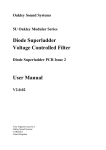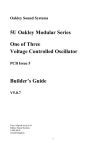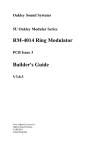Download Journeyman issue 2 User Manual
Transcript
Oakley Sound Systems 5U Oakley Modular Series Journeyman Diode Ring Filter Journeyman PCB Issue 2 User Manual V2.0.01 Tony Allgood B.Eng PGCE Oakley Sound Systems CARLISLE United Kingdom The suggested panel layout for the single width MOTM format module. 2 The suggested panel design for the full double width MOTM format module. 3 Introduction This is the User Manual for the issue 2 Journeyman Diode Ring Voltage Controlled Filter 5U module from Oakley Sound. This document contains an overview of the operation of the unit and the calibration procedure. For the Builder’s Guide, which contains a basic introduction to the board, a full parts list for the components needed to populate the boards, and a list of the various interconnections, please visit the main project webpage at: http://www.oakleysound.com/journey.htm For general information regarding where to get parts and suggested part numbers please see our useful Parts Guide at the project webpage or http://www.oakleysound.com/parts.pdf. For general information on how to build our modules, including circuit board population, mounting front panel components and making up board interconnects please see our generic Construction Guide at the project webpage or http://www.oakleysound.com/construct.pdf. 4 The Oakley Journeyman VCF Module This is the issue 2 Oakley Journeyman VCF module behind a natural finish 1U wide Schaeffer panel If our Superladder and SVF are well behaved perfect sounding filters, then this one is the rude boy of filter design. Its completely non-linear response and discrete circuitry gives it a unique sound of its own. Modelled after a classic Japanese filter design of the mid to late 1970s, the Journeyman can be configured in either high pass or low pass modes by the flicking of a switch. When two of these VCFs are used together, one in HP and the other in LP, then the effect is astounding. The filter heart is made entirely from a single ended discrete design and uses four matching diodes as the control elements. The filter behaves differently depending on the input signal level hence the 'drive' pot on the front panel. Turning this up allows the filter to be overdriven. At full resonance the filter will oscillate across most of the audio band. The design is intended to fit into a 1U wide 'filter-core' module or a more fully featured 2U wide panel with seven control pots. The 1U 'Filter Core' format is our way of handling filter modules. Although the 1U module can be used as a filter module on its own, it is expected that users will make use of external mixers to control CV and audio levels going into the filter. In this way, you will be able to have a collection of space saving 1U filter cores that can be used with any generic mixer module. The Oakley Multimix is an ideal choice for a handy mixer module. For the 2U design three audio inputs are provided each with its own attenuator. Three CVs can control the cut-off of the filter. One is fixed at approximately 1V/octave, the other two have input attenuators. CV2 features a reversible type attenuator with inverting/non-inverting properties. 5 Issue 2 Changes This is a significant new upgrade. The following items have been changed: 1. 16mm Alpha/ALPS pots as standard. 2. The main PCB now accepts our optional Sock4 socket board for easy wiring to the panel. 3. Cut-off frequency is less liable to wander over time and temperature. 4. Reduced effects from power supply noise. This shouldn't be a problem anyway but I did notice that some noisy modules like the old issue 1 Oakley VC-LFO did tend to 'infect' the output of the issue 1 Journeyman if placed near to it. 5. Reduced mains hum pick up. Again, most older units wouldn't have had this problem unless they were placed physically close to a power supply. The new issue 2 board reduces this pick up to a minimum. 6. Only one THAT300 NPN array is used and the recovery amplifier is now fully discrete. 7. Added resonance trim pot (RES) to allow for user setting of when self oscillation takes place. 8. The CV breakthrough trimmer (BAL) now works really well so CV breakthrough can be minimised to a greater degree. 9. Less of a volume jump when switching from LPF and HPF. 10. No appreciable volume drop as cut-off frequency goes above 20kHz. 6 The Filter Core Idea As you have read this module can be made into either a standard 2U wide module, or as a compact 1U filter core module. The Filter Core idea has come from the fact that many of our customers were buying different filter types, eg. they may have an MS-20 clone, a Moog ladder filter and an SVF. Each filter type gives a different sound so its worthwhile having a few in your modular set up. However, each filter module also has its own input mixer for audio and an input mixer for CVs. This adds to panel real estate and soon your modular is filling up very quickly. While this does look very impressive, it does mean that, in many patches, you have a lot of redundant electronics in your modular. Step forward the 'filter core'. This is quite simply a 1U module that contains only the filter and a few important front panel pots. All the audio and CV mixing is done externally with a dedicated mixer module, like the Multimix. The good thing about this is that any unused filter module is only 'wasting' 1U of panel space. So you can afford to have many different flavours of filter without the additional cost and panel space of mixers. However, as with all things, there are disadvantages too. The lack of inbuilt mixers mean that you will need to get more dedicated mixer modules. But remember that these relatively cheap mixer modules can be used for any mixing or level controlling within your modular. Thus, you have more flexibility, at the expense of a little more patching. The great thing about the Oakley Filter Core modules is that they will all be designed so that they can still be used in the full format design. All the Filter Core modules will have input summing amplifiers built onto the PCB. You won't be using these circuits in the 1U format, but they are there if you want to go for the larger 2U or 3U designs. 7 Calibration The module has four trimmers, two small single turn units and two multiturn ones. You should trim the module in the order given below. RES: This adjusts the maximum level of resonance obtainable with the resonance front panel control. There is no correct position for this trimmer since it should be set to personal taste. I prefer to have the filter just starting to self-oscillate with the resonance pot set to around 2 o'clock. In this case, simply set the resonance pot to this position and adjust RES until oscillation just starts to break out. You will find that the actual point self-oscillation occurs depends a little bit on the actual frequency of oscillation. Lower cut-off frequencies often need a higher resonance setting to self-oscillate. So have a play with the frequency and resonance pots and the RES trimmer to give you the response you like. You can always change it at a later date if you want your resonance control to be more or less sensitive. BAL: Turn the frequency and resonance pots to their middle positions. The filter should not be in oscillation – if it is, back off the resonance pot a bit until it stops. The drive and CV2 pots can be left anywhere. Now connect a 440Hz triangle wave signal to the CV 1 input socket, or KEY CV input socket on the 2U version. Listen to the audio output very carefully – you may need to turn up the volume a bit on your monitoring system. You should hear the 440Hz breaking through slightly. Adjust BAL to minimise the breakthrough. You won't get it to be completely silent but you should be able to find a point that produces less of a breakthrough than other positions. TUNE: This adjusts the filter’s cut-off frequency. Set this so that the filter’s frequency pot covers your chosen range. I would normally place this in the middle position for now, that is 10 turns or so, from one of the end points. SCLE: This adjusts the scaling of the exponential inputs. Adjust this so that there is an octave jump in cut-off frequency when the CV 1, or KEY CV on the 2U version, input is raised by one volt. Connect the CV1 or KEY CV socket to the 'keyboard CV' out of your midi-CV convertor or analogue keyboard. Your keyboard should produce a 1V change in output CV for every octave on the keyboard. Play an A on your keyboard and adjust the frequency pot so that the filter gives out a sine wave like signal of around 440Hz. Now play the A note one octave higher than you were pressing. By adjusting TUNE and SCLE you should aim to get the higher A to make the module give out 880Hz, ie. double 440Hz. However, any change in V/OCT will also change the lower note as well as the higher note. So you will have to move back and forth between altering TUNE and SCLE until you get the octave spread you require. Remember though that the Journeyman will not be able to be made to track perfectly over a very wide range. As such, even if you have achieved a perfect octave spread with your two A notes, you won't be able, for example, to hear a perfect octave spread from the two As an octave above those. However, since the action of the Journeyman is, for the most part, to 8 filter and not to act as a perfectly tuned oscillator this lack of accurate scaling should not be a problem. You should note that scaling is affected by the position of the BAL trimmer so remember to set BAL first before calibrating the scaling. Final Comments I hope you enjoy using the Oakley Journeyman Filter module. If you have any problems with the module, an excellent source of support is the Oakley Sound Forum at Muffwiggler.com. Paul Darlow and I are on this group, as well as many other users and builders of Oakley modules. If you have a comment about this user manual, or have a found a mistake in it, then please do let me know. Last but not least, can I say a big thank you to all of you who helped and inspired me. Thanks especially to all those nice people on the Synth-diy and Analogue Heaven mailing lists and those at Muffwiggler.com. Tony Allgood at Oakley Sound Cumbria, UK © March 2011 No part of this document may be copied by whatever means without my permission. 9















